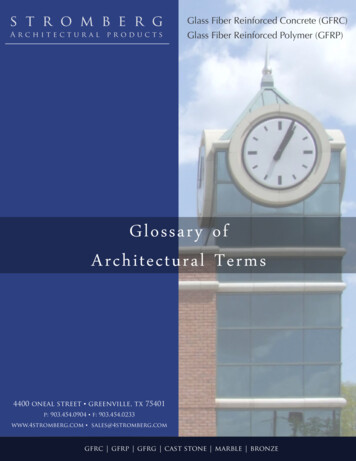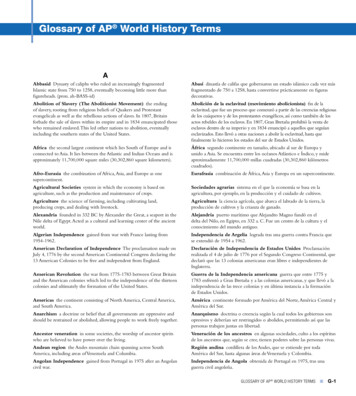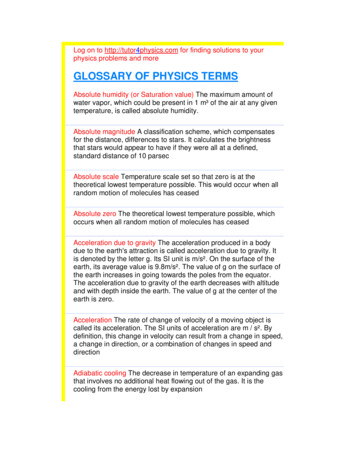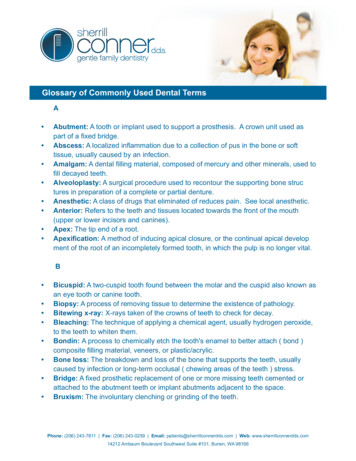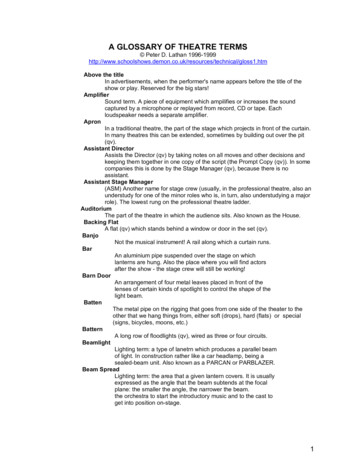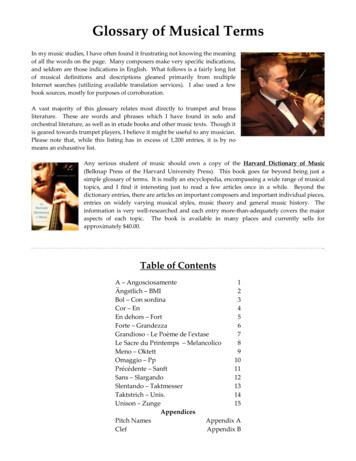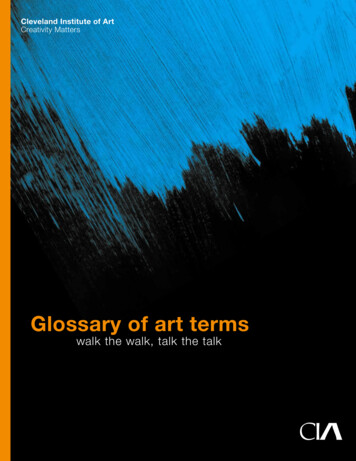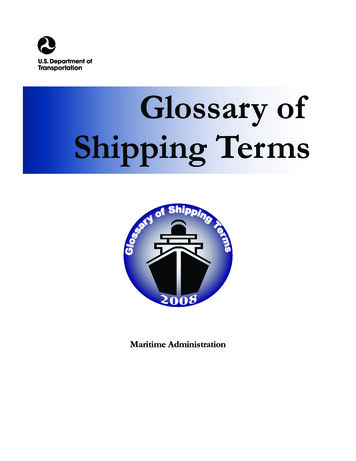
Transcription
GLOSSARY OFSTONE INDUSTRY TERMSAdditional references are listed at the end of this glossary.AAbaterepellents, coloring agents or to adjustthe curing rate of the concrete or mortar.In stone carving, to cut away material, AdoquinA volcanic, quartz based stone containing aleaving parts in relief.variety of colored aggregates and pumiceAbrasive Finishin a quartz matrix. Quarried in Mexico.A non-reflective surface finish. An abrasivefinish may be defined by the grit size of AgateA variegated, translucent, cryptocrystalthe abrasive.line variety of quartz showing coloredAbrasive Hardness (Ha)bands or other markings (clouded, mossA measure of the wearing performance like, etc.).of stone for floors, stair treads, and otherareas subjected to abrasion by foot traffic. Agglomerated StoneA manmade product composed of crushedRefer to ASTM C241 and C1353.stone combined with resin. See also enAbsorptiongineered stone and cultured stone.The amount of water absorbed by a stone,expressed as a percentage by weight. Refer AggregateA small mass of rock, having occurredto ASTM C97.naturally (as in sand or gravel) or by meansAbutmentof manufacture (as in a crushed aggregateA solid stone “springer” at the lowest product), used either in a loose, noncohesivepoint of an arch or vault.state, or as an ingredient in mortar orconcrete products.AcceleratorIn masonry, any ingredient added to mortaror concrete to speed the curing process.Acid WashA treatment applied to the face of a stoneto achieve a texture or finish that is distressed. Most acidic chemical treatmentsare effective only when applied to calcareous stone varieties.AlabasterA fine grained and translucent varietyof gypsum, generally white in color. Commonly used in decorative applications as itis can be cut and carved easily with a knifeor saw. Term is often incorrectly appliedto fine grained marble.AlkalinePertains to a highly basic, as opposed toacidic, substance; for example, hydrogenUsed in reference to stone veneer, or carbonate of sodium or potassium.secured and supported by adhesion ofan approved bonding material over an Allowable Capacityapproved backing.The safe load that can be resisted by astone anchor, determined by dividing theAdmixtureultimate capacity by the factor of safety.A material other than water, aggregates,lime or cement, added to concrete or Ambient Temperaturemortar at the time of mixing. Admixtures Temperature of the surrounding environare typically added to function as water ment.AdheredGlosssary of Terms 2011 Marble Institute of Americawww.marble-institute.com 23-1
AnchorA corrosion resistant metal fastener usedfor securing dimension stone to a structure or adjacent stone units. Anchor typesfor stonework include those made of flatstock (straps, dovetails)and round stock(rod cramp, rod anchor, eyebolt and dowel).Angle of ReposeAnchorageThe means by which slabs are secured to aself supporting structure.Angle of ReposeApronArgilliteA weakly metamorphosed compact rockcomposed mainly of clay and shale. Usedlocally as building stone, although rarelyproduced commercially.ArkoseA feldspar-rich sandstone containing 10%or more clastic grains of feldspar. Alsocalled “arkosic sandstone” and “feldspathicsandstone.”ArrisThe angle a normal pile of loose material A slight, although measurable, chamfermakes to the horizontal. Used as an indi- where two surfaces meetcator of flowability; the steeper the slope,Artificial Stonethe more sluggish the flow.A manmade product attempting toAnisotropicreplicate the look of natural stone. ThisHaving properties, either visual or me- term is actually a misnomer, as it includeschanical, that differ based on the direction an obvious contradiction of terms. Stonein which they are measured. All stones are is naturally occurring earth material. Seeanisotropic to some degree, but the sedi- engineered stone and culturedmentary stones typically have the greatest marble.degree of anisotropy.AnorthositeAshlarApronASIA stone façade of generally square orrectangular units having sawed or dressedbeds. There are three generally recogANSInized distinctions:American National Standards Institute1. random ashlar: ashlar set withAntique Finishstones of varying length and height soA finish that replicates rustic or distressed that neither vertical nor horizontaltextures. Produced through mechanical joints are continuous.or chemical means to simulate the naturally2. coursed ashlar: Ashlar set to formoccurring effects of the aging process.continuous horizontal joints.Apex Stone3. stacked ashlar: Ashlar set to formUppermost stone in a gable, pediment, continuous vertical joints.vault or dome.A dark-colored igneous rock consistingmostly or entirely of calcic itute.com(Allied Stone Industries)A trim piece under a projecting stone top, The Allied Stone Industries is made up ofstool, etc.stone quarriers, fabricators, and the supArchpliers of natural building materials andThe curved or pointed construction over related machinery and tools.a doorway or opening. Arch shapes rangefrom flat to semicircular or semielliptical ASTM InternationalA consensus standards authoring organito acutely pointed.zation originally founded 1896 as AmeriArchitravecan Society for Testing Materials.The beam or lowest division of the entablature in the classical orders, spanning Axed Work (British)from column to column. The decorated Hand-dressed stone surface showing finesurrounds of a window or door at the to-course, generally linear toolmarks madeby axe, pick or bush hammer.head and jamb.Glosssary of Terms 2011 Marble Institute of America
BBasaltA dark colored, igneous rock commercially known as granite when fabricatedAny of a variety of anchors that extends as dimension stone. The fine-grained andfrom the back surface of a stone panel, extrusive equivalent of gabbro.as opposed to anchors that penetrate the Baseedges of a stone panel.In masonry, the bottom course of a stonewall, or the vertical first member aboveBacker Rodgrade or a finished floor.A flexible and compressible type of closedcell foam polyethylene, butyl rubber, or Basicopen-cell or closed-cell polyurethane, In geology, one of four subdivisions usedto classify igneous rocks based on silicarounded at surface to contact sealant. content: acidic, intermediate, basic andThe backer rod is positioned within the ultra-basic. Said of igneous rock containjoint so as to maintain appropriate depth ing relatively low silica content (approx.and crosssectional shape of the bead.45 to 50%).Batted Work (British)Back-pargingHand-dressedstone surface scored topThe process of slathering the back of antobottominnarrowparallel strikes, usingadhered stone unit with an adhesive maa batting tool. Strokes may be verticalterial to reduce or eliminate voids in ad- (in which case the surface may be calledhesive contact. Also used in travertine or tooled) or oblique, and may range fromwith the application of damp proofing. 8 to 10 per inch. Batting is also calledAlso referred to as “back-buttering.”“broad tooling,” “droving,” or “angle dunting.”Back AnchorBacksplashA vertical covering of the wall where acountertop surface meets the wall surface, designed to protect the wall frommoisture. Backsplashes range from a fewinches in height to “full height backsplashes”that extend from the countertop surfaceto the underside of the upper cabinets.Coursed AshlarRandom AshlarBearing CheckA slot, generally not continuous, cut intothe back or bed of dimension stone toallow entry of a supporting angle or clip.Bed JointA horizontal joint between stones, usuallyfilled with mortar or sealant.Bed1. The top or bottom of a joint, naturalbed; surface of stone parallel to itsA structural support wall erected behind stratification.stone or brick facing.2. In granites and marbles, a layer or sheetof the rock mass that is frequentlyBalusterhorizontal, commonly curved andA short post or vertical member in alenticular, as developed by fractures.series that supports a railing or coping Sometimes also applied to the surfaceforming a balustrade. Balusters are tradi of parting between rock sheets.tionally decorative forms that are turned 3. In stratified rocks, the unit layer formedon a lathe.by sedimentation; of variable thickness,and commonly tilted or distorted byBalustradeA railing system with top rail, balusters subsequent deformation.It generallydevelops a rock cleavage, parting, orand bottom rail.jointing along the planes of stratification.Backer RodBack-up StructureBand CourseSee string course.BankerBench of timber or stone (may be a singleblock) on which stone is worked.Bearing CheckBedding PlanePlane of sedimentary stone in the positionof its original formation. This plane maybe horizontal, coincident with mountainslopes, or random.Glosssary of Terms 2011 Marble Institute of AmericaBedding Planewww.marble-institute.com 23-3
BedrockBlockGeneral term referring to the rock un- See quarry block.derlying other unconsolidated material,Bluestonesuch as soil.A fine- to medium-grain, quartz basedBelt Coursestone of the U.S. Appalachian Plateau.A continuous horizontal course, marking The stone is well known for relativelya division in the wall plane.easy cleavage along generally flat planes,Benchmaking it a common choice for naturallySteps formed in a quarry by removal of cleft products such as flagstone. The termstone. Also, a long seat of cubic stone. “bluestone” may be used in other parts ofbevel. A term describing the intersection the world to describe very dissimilar reof two surfaces meeting at an angle other gional products.than 90 degrees.BollardBlack GraniteBook Match PatternRock species known to petrologists as diabase, diorite, gabbro and other varietiesquarried as dimension stone. As dimension blocks or slabs, they are valued specifically for their dark grey to black colorwhen polished. Scientifically, they are farremoved in composition from true granites though they may be satisfactorily usedfor some of the purposes to which commercial granites are adapted. They possessan interlocking crystalline texture, butunlike granites, they contain little or noquartz or alkalic feldspar, and are characterized by an abundance of one or moreof the common black rock-formingminerals (chiefly pyroxenes, hornblende,and biotite).Blade DressingA maintenance process required periodically to restore optimum performanceof diamond abrasive cutting tools. Theprocess consists of cutting or grindinginto a softer material which will abradeat the matrix and expose new diamondsurfaces. Dressing is frequently done withmanufactured dressing sticks, soft brick,and some abrasive sandstones.A free standing stone post or guard.Bond1. Pattern of joints in successive courses.2. To stick or adhere.Book Match PatternA vein matching technique where opposite faces of adjacent slabs are exposed,producing a repeating mirror image ofthe veining trend of the material. Bookmatched material is most commonlypolished to allow the greatest visibility ofthe veining character of the stone.Border StoneUsually a flat stone used as an edgingmaterial. A border stone is generally usedto retain or define the pattern around thefield of paving.BossIn masonry, a roughly shaped stone set toproject for carving in place. A carvedornamentation to conceal the jointing atthe junction of ribs in a Gothic vault.BoulderBleedNaturally rounded rock fragment largerthan 256 mm diameter. Used for crudewalls and foundation, generally in mortar.BlendingBrecciaStaining caused by corrosive metals,oil based putties, mastics, caulking, or BowingA warping or curving of a stone unit.sealing compounds.The random positioning of adjacentveneer panels, floor slabs, or tiles, toprevent large regions of uniform color,contrasted by adjacent large regions ofdissimilar uniform color.23-4www.marble-institute.comRock characterized by course, angularfragments, either the result of crushingand recementing essentially in place, ordeposition of angular pieces that becomeconsolidated. Numerous marbles oweGlosssary of Terms 2011 Marble Institute of America
their distinctive appearance to the BSIbrecciation caused by metamorphism. (Building Stone Institute)Italian for, “broken stones, rubble.”A trade association of quarriers, fabricators, dealers, and others working withBrecciated MarbleAny marble composed of angular natural stone. Founded in 1919, sponsorof the Tucker Architectural Awards.fragments.Bridge CraneA hoisting system that consists of a hoist,normally using cables, which moves ona beam or “bridge” spanning an opening between two rails. The hoist moveslaterally along the bridge and the bridgemoves longitudinally along the rails,allowing the hoist to be over any positionwithin the rectangle contained within thelengths of the two rails.Bridge PolisherA single spindle polishing machine thattravels along a beam, or “bridge”, whichtravels atop two rails. Also known as a“gantry” polisher.Bugged FinishA smooth finish produced in limestone bygrinding with power sanders.Building StoneRock material in its natural state of composition and aggregation as it exists in thequarry and is usable in constructionas dimension building stone. Also usedinterchangeably with the term dimensionstone.BullnoseConvex rounding of a stone edge, such asa stair tread or countertop.Bush HammeringA process which produces texturedA saw that travels along a beam, or surfaces with small evenly spaced pits“bridge”, which travels atop two rails. produced by hand or pneumatic hammer.These saws are typically powerful and The spacing between the pits is oftenfitted with large diameter blades. A defined as “6-cut,” “4-cut,” etc.rotating table is positioned below the Butt Jointsaw, allowing for skew cuts, and the saw An external corner formed by two stonearbor typically rotates, allowing for panels with one finished edge in a lapangled cuts.joint configuration.Bridge SawBroach1. To drill or cut out material leftb
leaving parts in relief. Abrasive Finish A non-reflective surface finish. An abrasive finish may be defined by the grit size of the abrasive. Abrasive Hardness (Ha) A measure of the wearing performance of stone for floors, stair treads, and other areas subjected to abrasion by foot traffic. Refer to ASTM C241 and C1353. Absorption The amount of water absorbed by a stone, expressed as a .

